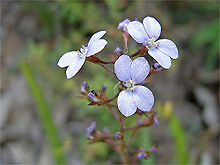| Stylidiaceae | |
|---|---|

| |
| Stylidium amoenum | |
| Scientific classification | |
| Kingdom: | Plantae |
| Clade: | Tracheophytes |
| Clade: | Angiosperms |
| Clade: | Eudicots |
| Clade: | Asterids |
| Order: | Asterales |
| Family: | Stylidiaceae R.Br. |
| Genera | |
| Synonyms | |
|
Candolleaceae F.Muell. | |
The family Stylidiaceae is a taxon of dicotyledonous flowering plants. It consists of five genera with over 240 species, most of which are endemic to Australia and New Zealand. Members of Stylidiaceae are typically grass-like herbs or small shrubs and can be perennials or annuals. Most species are free standing or self-supporting, though a few can be climbing or scrambling (Stylidium scandens uses leaf tips recurved into hooks to climb).
The pollination mechanisms of Stylidium and Levenhookia are as follows: In Stylidium the floral column, which consists of the fused stamen and style, springs violently from one side (usually under the flower) when triggered. This deposits the pollen on a visiting insect. In Levenhookia, however, the column is immobile, but the hooded labellum is triggered and sheds pollen.
In 1981, only about 155 species were known in the family.[1] The current number of species by genus (reported in 2002) is as follows: Forstera - 5, Levenhookia - 10, Oreostylidium - 1, Phyllachne - 4, and Stylidium - 221. These numbers, especially for Stylidium, are changing rapidly as new species are described.[2]
Stylidium rotundifolium appeared in Joseph Banks' Florilegium (plate 173), drawn from a specimen collected at Endeavour River, Australia in 1770.[3]
- ^ Cronquist, Arthur (1981). An Integrated System of Classification of Flowering Plants. New York: Columbia University Press. pp. 986–987. ISBN 0-231-03880-1.
- ^ Wagstaff, S.J. and Wege, J. (2002). Patterns of diversification in New Zealand Stylidiaceae. American Journal of Botany, 89(5): 865-874. (Available online: HTML or PDF versions).
- ^ "'Discovering the Unexpected' · Type & Forme". www.typeandforme.com. 6 October 2018. Retrieved 10 October 2018.